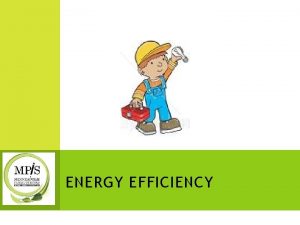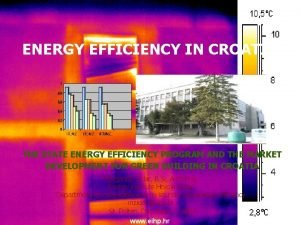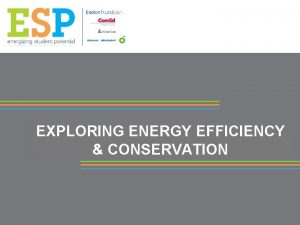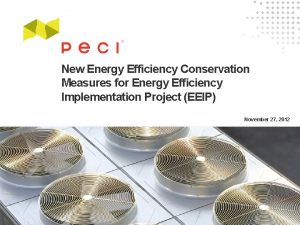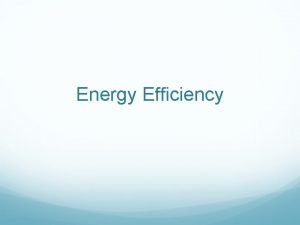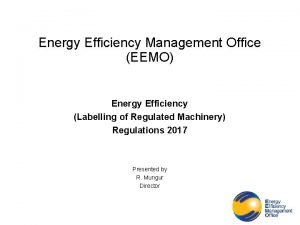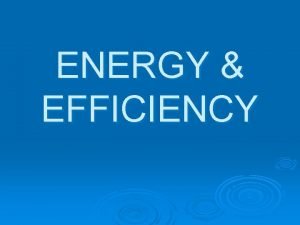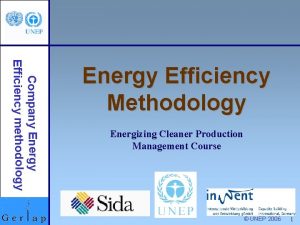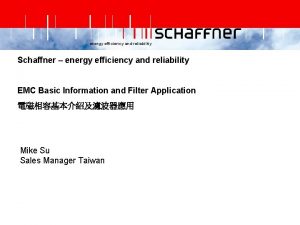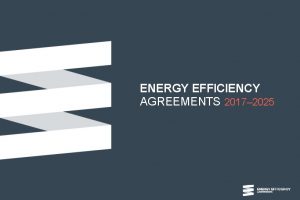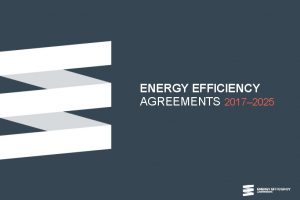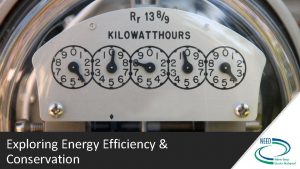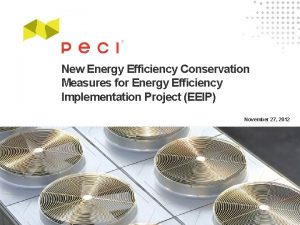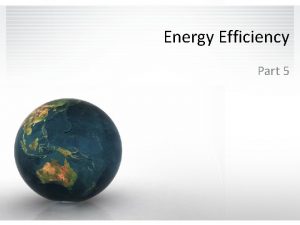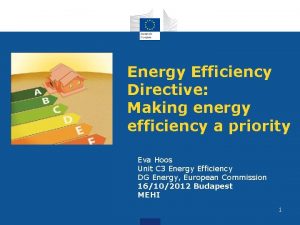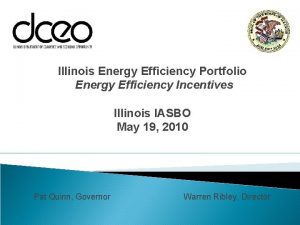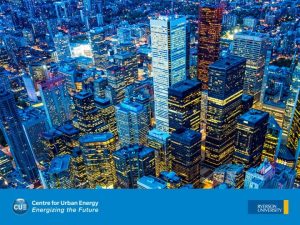Energy efficiency Introduction of the Energy efficiency in





















- Slides: 21

Energy efficiency: Introduction of the Energy efficiency in the company Towards a Sustainable Agro-Food Industry. Capacity Building Programmes in Energy Efficiency. This project has received funding from the European Union’s H 2020 Coordination Support Action under Grant Agreement No. 785047.

Energy management Why do you need a company to make an effective use of energy? EFFECTIVE The cost of energy can be managed Regulatory control and establishment of limits (energy regulation, CO 2 emissions, . . . ). Can be a customer requirement. To increase market value mercad. Energy Corporate responsibility. Social pressure. Towards a Sustainable Agro-Food Industry. Capacity Building Programmes in Energy Efficiency. Review Meeting | Brussels 2

Energy management Benefits for your company Cost savings and improvement of competitiveness. More information in your company. • Strategic planning and opportunity for improvement. Risk reduction Motivation for employees Image Towards a Sustainable Agro-Food Industry. Capacity Building Programmes in Energy Efficiency. Review Meeting | Brussels 3

Energy efficiency in industrial energetic uses: The energy consumption and associated costs are related to technical and human factors. To analyze the use of energy in your company, it is necessary to consider the following points: Lighting system Industrial refrigeration Electric drives Process heating Compressed air systems Pumping Steam production Office equipment Towards a Sustainable Agro-Food Industry. Capacity Building Programmes in Energy Efficiency. Energy efficiency in industries 4

Lighting system Towards a Sustainable Agro-Food Industry. Capacity Building Programmes in Energy Efficiency. Energy efficiency in industries 5

Energy efficiency in industrial energetic uses: Natural light • • Investments: Maximize the use of natural light. Reduce artificial minimum levels. lighting • Install timers and / or presence sensors (10% to 20% savings) in services, corridors, basements, garages. . . • Install drivers for the use of daylight in each area that receives natural light. to Turn off the switch • • Turn off the lights if they are not needed and in areas that are not occupied. Divide the lighting so that there are different switches is to control different sections. Together, these investments can reduce energy consumption and costs up to 45%. • Replace the electromagnetic coils of fluorescent tubes with more efficient electronic ballasts. • Switch to efficient lighting. Light colors • Choose light colors for the interior walls of the building. • The darker the colors, the more artificial light will be needed. Towards a Sustainable Agro-Food Industry. Capacity Building Programmes in Energy Efficiency. Energy efficiency in industries 6

Energy efficiency in industrial energetic uses: Towards a Sustainable Agro-Food Industry. Capacity Building Programmes in Energy Efficiency. Energy efficiency in industries 7

Electric drives TAKE AN INVENTORY Take an inventory of the installed electric motors with the following methodology: • • • CORRECT SELECTION Identify the engines and the associated process (pumping, ventilation, drives…); Identify the electrical characteristics: power, demand current, voltage, power factor, operation regime; Knowledge of the number of hours the engine operates; Load or demand factor; Maintenance program; Consumption as possible (meter or grid analyzer for measurement). OF THE ENGINES It is very common to see oversized engines, which makes the nominal power too high compared to what is needed to cover the needs REPLACE OLD ENGINES VFD: Replace old engines with new ones with high efficiency. • • Install Variable Frequency Drive. The objective is to modify the engine speed to ensure that it is always operating in optimal conditions. Towards a Sustainable Agro-Food Industry. Capacity Building Programmes in Energy Efficiency. Energy efficiency in industries 8

Compressed Air Towards a Sustainable Agro-Food Industry. Capacity Building Programmes in Energy Efficiency. Energy efficiency in industries 9

Compressed Air DRYER REGULATION • Install more dryers performing. • Avoid regulations by throttling of the suction air • Check regularly the pressure drops of the driers. • Avoid the no-loads of air compressor. • Respect the periodicities of maintenance. • Install an electronic variation speed to adapt production to the real need of compressed air. • If necessary, call in a refrigeration specialist qualified for the maintenance of the cold circuit. HEAT RECOVERY • Close the not used network’s parts. FILTERS • Look for and seal leaks regular (at least once a year). • The leaks are responsible for a significant waste, frequently around 40 to 50% of the overall consumption. • Install a management system and regulation of compressors cascade according to the need of air COMPRESSED AIR NETWORK • Closing the network to limit the gaps pressure at the end of the network PNEUMATIC TOOLS • Replace tools if possible pneumatic power tools. The price of the pneumatic k. Wh is 20 times higher than the price of the electric k. Wh. Towards a Sustainable Agro-Food Industry. Capacity Building Programmes in Energy Efficiency. Energy efficiency in industries 10

Pumping PUMPS • Replace or modify pumps oversized. VALVES • Choose the pump according to the needs of the system • Install electronic speed variation when it allows to increase the energy efficiency of the pumping system. • Apply a coating that reduces friction inside the wheel and the volute centrifugal pumps • Stop the pumps when they do not need to be Operating. Do not pump for nothing. • Restore internal tolerances shoes • Identify the pumps in cavitation VALVES • Recover the rejected heat by the compressor for space heating or water production hot. • About 80% of electric power compressor is transformed into heat. PROCESS • Put in place a monitoring system for the entire network. Towards a Sustainable Agro-Food Industry. Capacity Building Programmes in Energy Efficiency. Energy efficiency in industries 11

Industrial Refrigeration Towards a Sustainable Agro-Food Industry. Capacity Building Programmes in Energy Efficiency. Energy efficiency in industries 12

Industrial Refrigeration Speed variation Storage • Install speed variation on at least one of the compressors • For screw compressors, privilege the regulation of power by speed variation rather than by drawer. • Install a cold buffer storage if necessary. It is also possible to size the decoupling bottle so that she can eventually play a storage role. Compressors Heat recovery • For low temperatures, use two-stage cycles or cycles to economizer. • Install power compressors judiciously tiered to cover better the whole range of powers called. • Install a recovery system heat on the cold group • For screw compressors: recover the heat on the oil circuit. • Up to 25% rejected heat can be valorized at a temperature of 50 - 60 ° C. Evaporator • Prefer large sized evaporators to reduce pinching. • 10% more surface is 1°C won, so 2 to 3% of the energy consumed. Lightning Lighting is a contribution of heat • Set up efficient lighting systems in the cold rooms Distribution • Regulate the flow of refrigerant fluid by electronic speed variation on the secondary distribution pump. • Regulate the coolant flow on the primary circuit versus flow on the secondary circuit. Insulation & Defrost • Check the state of the cold circuit insulation and repair if necessary. • Adopt a strategy adequate and powerful of defrosting Cold room openings • Set up protection's effective openings (curtains with straps, air curtains, quickopen doors). • Set up buffer locks and decrease openings / closures of the area. • Inlets can be responsible for 20 to 40% of the balance sheet refrigeration system. Towards a Sustainable Agro-Food Industry. Capacity Building Programmes in Energy Efficiency. Energy efficiency in industries 13

Process heating burner hhot water Cool water gases output fuel input Gas circuit Towards a Sustainable Agro-Food Industry. Capacity Building Programmes in Energy Efficiency. Energy efficiency in industries 14

Process heating 1 ° C temperature increases = The energy saving approximately 6% THERMAL ISOLATION MEASURES WITHOUT COST Thermal insulation in boilers, hot water tanks and water pipes. Adjust the temperature of rooms and boilers HIGH EFFICIENCY BOILERS • Condensing boiler: designed to utilize the latent heat released by the condensation of the water vapor. CLEAN THE BOILER 1 mm of soot = 50 ° C smoke temperature = loss of performance of 4% -8% • About 109% efficiency • Up to 40% savings compared to conventional boilers OTHER MEASURES • Place a temperature control on the heating system. • Choose hot air instead of hot air systems • Recover the heat from the ventilation and reuse it. • Reduce the zones to heat. • Large consumers of electricity and thermal energy should consider cogeneration. • It is advisable to use solar collectors to heat the water Towards a Sustainable Agro-Food Industry. Capacity Building Programmes in Energy Efficiency. Energy efficiency in industries 15

Steam production Thermodynamic With float Towards a Sustainable Agro-Food Industry. Capacity Building Programmes in Energy Efficiency. Energy efficiency in industries 16

Steam production HEAT RECOVERY Install a recovery system heat lost during purges, you can save between 1 and 4% of energy. STEAM NETWORK • Repair leaks regularly. A single leak of 3. 18 mm diameter on a steam network at 7 bar causes a loss of € 3, 900 / year. • Driving with insulation wet gives way 30 times more only when it is dry. ECONOMIZER • Install an economizer to preheat the water supply of a steam boiler. • Energy savings of 2 to 5% are possible. STEAM TRAP • Check the traps regularly. • In installations where the traps are not frequently checked, 30% of them can be defective and run away. • Regular monitoring can lower this rate to 5%. SUPPLY OF WATER A supply of water not insulated can lose up to 70% of its thermal energy. ECONOMIZER If possible, reduce the pressure of the network. If there are regulators at the entrance of all consumers, a network high pressure is not necessary. Towards a Sustainable Agro-Food Industry. Capacity Building Programmes in Energy Efficiency. Energy efficiency in industries 17

Office equipment Towards a Sustainable Agro-Food Industry. Capacity Building Programmes in Energy Efficiency. Energy efficiency in industries 18

Office equipment Computers • The most important consumption of the office. • Computers and monitors with the "ENERGY STAR" condition hibernate automatically when they are not used and almost all vendors sell them. • Both computers and monitors in hibernation consume approximately 15% of their maximum power of use. Other tips • Turn off the computer when it is not in use (at night or on weekends). There are timers that turn off the equipment at certain times of the day. • If the computer has to be on during the night or during weekends, save money by turning off the monitor. Photocopiers and printers • "ENERGY STAR" photocopiers can reduce the annual electric cost of photocopiers by up to 60%. • Photocopiers that allow double-sided or duplex copies help save energy and reduce the cost of paper. FAX • The fax needs to be available 24 hours a day, therefore, it has a great potential to save energy. • It can hibernate up to 15 to 45 watts or less when not in use, and can save approximately 50% in its annual energy cost. • The energy saving features have to be established by the user in many products. Check the configuration periodically or each time you install new equipment to ensure that the power saving mode is on. • Screen protectors do not save energy. Its purpose is to extend the useful life of the screen. • Laser printers consume more energy than inkjet printers. Color printers use more energy than those that only print in black and white. • Laptops consume much less than a PC. Towards a Sustainable Agro-Food Industry. Capacity Building Programmes in Energy Efficiency. Energy efficiency in industries 19

Thanks For Your Attention! This project has received funding from the European Union’s H 2020 Coordination Support Action under Grant Agreement No. 785047.

TOWARDS A SUSTAINABLE AGRO-FOOD INDUSTRY. CAPACITY BUILDING PROGRAMMES IN ENERGY EFFICIENCY.
 Allocative efficiency and productive efficiency
Allocative efficiency and productive efficiency Allocative efficiency vs productive efficiency
Allocative efficiency vs productive efficiency Allocative efficiency vs productive efficiency
Allocative efficiency vs productive efficiency Renewable energy and energy efficiency partnership
Renewable energy and energy efficiency partnership Hát kết hợp bộ gõ cơ thể
Hát kết hợp bộ gõ cơ thể Frameset trong html5
Frameset trong html5 Bổ thể
Bổ thể Tỉ lệ cơ thể trẻ em
Tỉ lệ cơ thể trẻ em Gấu đi như thế nào
Gấu đi như thế nào Glasgow thang điểm
Glasgow thang điểm Bài hát chúa yêu trần thế alleluia
Bài hát chúa yêu trần thế alleluia Các môn thể thao bắt đầu bằng từ đua
Các môn thể thao bắt đầu bằng từ đua Thế nào là hệ số cao nhất
Thế nào là hệ số cao nhất Các châu lục và đại dương trên thế giới
Các châu lục và đại dương trên thế giới Công thức tiính động năng
Công thức tiính động năng Trời xanh đây là của chúng ta thể thơ
Trời xanh đây là của chúng ta thể thơ Cách giải mật thư tọa độ
Cách giải mật thư tọa độ 101012 bằng
101012 bằng Phản ứng thế ankan
Phản ứng thế ankan Các châu lục và đại dương trên thế giới
Các châu lục và đại dương trên thế giới Thơ thất ngôn tứ tuyệt đường luật
Thơ thất ngôn tứ tuyệt đường luật Quá trình desamine hóa có thể tạo ra
Quá trình desamine hóa có thể tạo ra






















